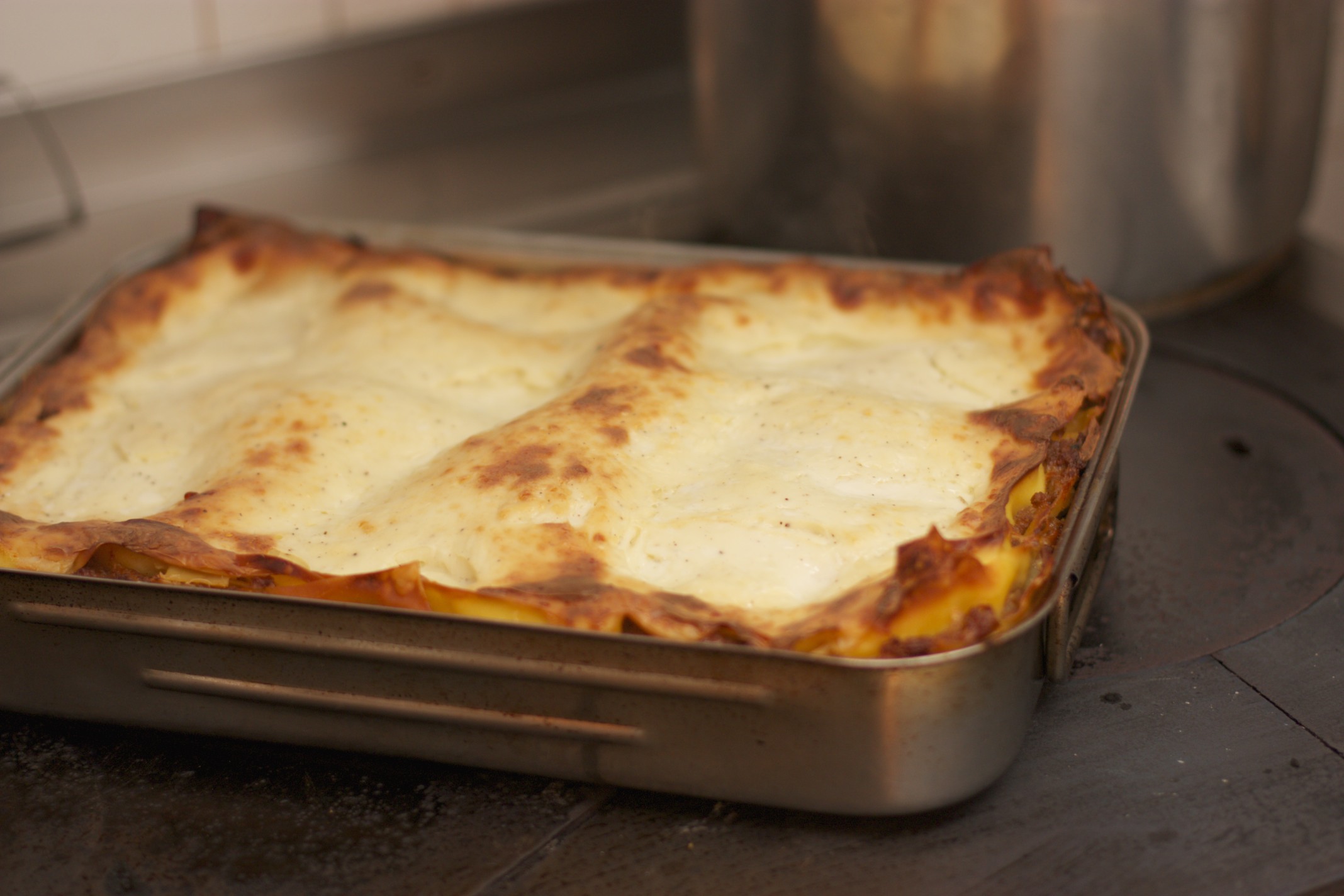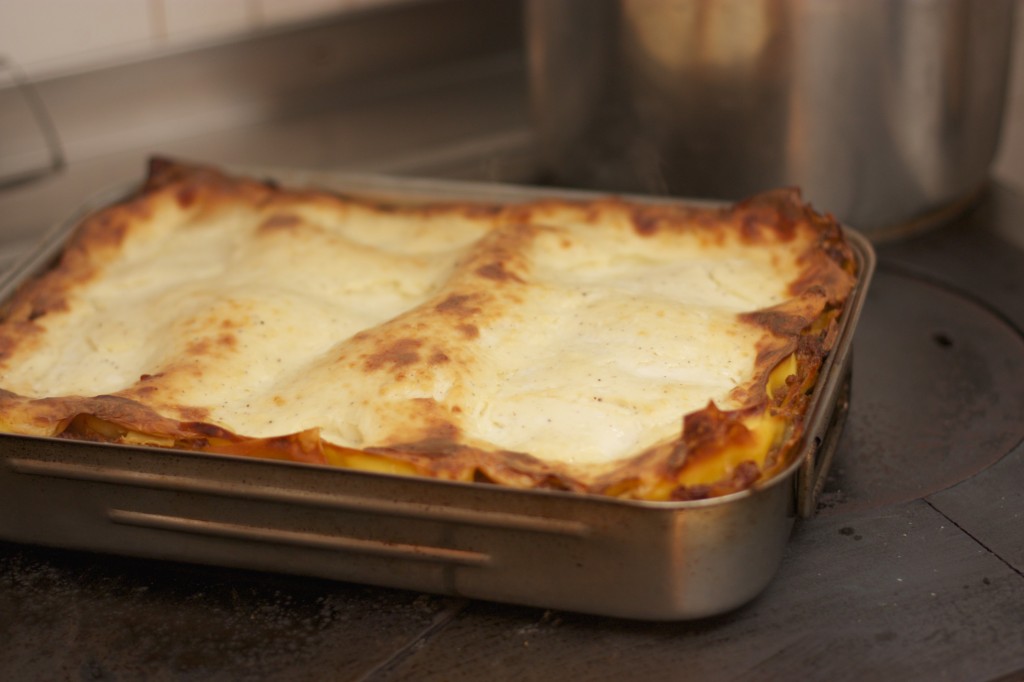This post is also available in: English
Nella mia adolescenza il pranzo della domenica si apriva con il pasticcio di lasagne al ragù.
La preparazione del pasticcio era vissuta come un’innovazione frutto delle sbirciatine che mia zia dava al lavoro della cuoca che veniva ingaggiata per preparare pranzi di battesimo, cresime, nozze e altri eventi speciali.
La preparazione della sfoglia all’uovo il sabato pomeriggio era anche l’occasione per smaltire le tante uova che producevano le galline del nostro pollaio.
Tutto era prodotto nella nostra fattoria: la farina dalla macina dal grano dei campi, il latte per la besciamella delle mucche presenti in stalla, la carne macinata frutto della macellazione di qualche animale, il formaggio grattugiato ricavato da forme di formaggio stagionate.
Gli uomini della famiglia apprezzavano molto questa ricetta così come gli ospiti che spesso erano presenti alla tavola della domenica.
Io normalmente collaboravo nella preparazione della sfoglia e nel mescolare la besciamella.
Quel pasticcio mi dava la sensazione di appartenente a una famiglia solida dove ci si sente sicuri e dove c’è sempre qualcosa di buono da portare in tavola.
Negli anni, diventata adulta ho sperimentato varie ricette di pasticcio, con verdure e con besciamella vegetale che preferisco ma, ogni tanto mi piace ritornare al vecchio pasticcio della domenica, corposo e saporito, un modo per rendere omaggio alla storia della famiglia e ricordarla anche alle nuove generazioni.
Oggi in commercio ci sono sfoglie di pasta per pasticcio già pronte. Una scatola di queste può sostituire la ricetta della pasta fatta a mano che vi descrivo.
Pasticcio della Domenica
8
servings2
hours40
minutesIngredientI
- Per la sfoglia
300 gr. di farina + un poco per lavorare la pasta
3 uova
Poco sale
- Per il ragù
700 gr. di carne macinata di manzo magra
2 salsicce
2 carote
1 cipolla dorata
2 gambi di sedano
1 piccolo mazzetto di prezzemolo
1 barattolo di pomodori pelati
1 bicchiere di vino bianco
1 grattugiata di noce moscata
2 cucchiai di olio di oliva extravergine
Pepe e sale
- Per la besciamella
1 litro e mezzo di latte
6 cucchiai di farina
150 gr. di burro + un poco per imburrare la teglia
150 gr. di parmigiano reggiano
Indicazioni
- Per il ragu
- Preparare un trito di cipolla, sedano, carota, prezzemolo. Versare in un’ampia casseruola due cucchiai di olio extravergine di oliva, aggiungere il trito di verdure e le salsicce sminuzzate, la carne macinata. Far soffriggere velocemente per circa dieci minuti.
- Versare quindi il vino bianco e lasciare evaporare per qualche minuto. Aggiungere i pomodori pelati, salare e pepare. Abbassare la fiamma a fuoco medio/basso. Continuare la cottura lentamente per circa 1 ora e 30 minuti..
- Per la pasta
- Impastare la farina con le uova e un po’ di sale, se risulta troppo difficile da impastare aggiungere un cucchiaio di latte. Lavorarla molto con le mani, battendola spesso sul tavolo; dovrà risultare molto elastica. Quando e pronta avvolgerla in un foglio trasparente e lasciarla riposare almeno un’ora.
- Per la besciamella
- Mettere a scaldare il latte e spegnere appena alza il bollore.
- In una casseruola a bordi alti versare il burro e farlo sciogliere, quando e sciolto e bollente versare la farina. Con un mestolo di legno girare velocemente e cuocere fino a che la farina assume un colore dorato.
- A questo punto aggiungere con un mestolo, piano piano, il latte mescolando accuratamente per evitare che si formino grumi. Quando il latte e stato tutto assorbito la besciamella e pronta. La consistenza deve essere cremosa non troppo liquida non troppo densa. Aggiungere poco sale e una grattugiata di noce moscata.
- Versare meta della besciamella nel ragu per renderlo cremoso, conservarne la meta per la copertura finale.
- Cottura della Pasta e Assemblaggio
- Tirare quindi la sfoglia. Dividere la palla in 4/5 pezzi, infarinare ciascuno con un po’ di farina e passare la pasta su una macchinetta per la pasta o tirarla con il matterello, la pasta va prima posta sul foro più largo della macchinetta e successivamente via via su quelli più sottili fino ad ottenere una sfoglia elastica e sottile.
- Dividetela in fogli rettangolari della lunghezza della teglia che avete a disposizione per il pasticcio, consiglio una teglia rettangolare di acciaio o di porcellana.
- Mettere a bollire acqua salata con un cucchiaio di olio di oliva e, quando bolle versare le sfoglie poche per volta e farle cuocere per 5 minuti.
- Sistemare una vecchia tovaglia sul tavolo, con un mestolo forato togliere le sfoglie dall’acqua bollente e sistemarle sulla tovaglia.
Imburrare la teglia, mettere un primo strato di pasta, versare poco ragù e una spolverata di parmigiano. Ripetere l’operazione finché la teglia sarà quasi riempita. Si deve terminare con uno strato di pasta. - A questo punto spalmare sull’ultimo strato tutta la besciamella rimasta in modo che formi una specie di coperchio e spolverare con il parmigiano rimasto. Infornare a 200 gradi. Il pasticcio è cotto quando si è formata una crosticina dorata dopo circa 40 minuti.
Servire ben caldo tagliato a grossi quadrati.





